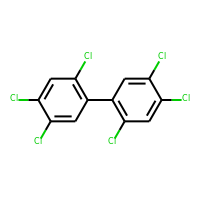| Chemical | Gene Symbol | Gene Name | Interaction source |
|---|
| 2,4,5,2',4',5'-Hexachlorobiphenyl | HMGA1 | high mobility group AT-hook 1 | CTD |
| 2,4,5,2',4',5'-Hexachlorobiphenyl | CYP1A2 | cytochrome P450 family 1 subfamily A member 2 | CTD |
| 2,4,5,2',4',5'-Hexachlorobiphenyl | CASP9 | caspase 9 | CTD |
| 2,4,5,2',4',5'-Hexachlorobiphenyl | HK2 | hexokinase 2 | CTD |
| 2,4,5,2',4',5'-Hexachlorobiphenyl | DDIT3 | DNA damage inducible transcript 3 | CTD |
| 2,4,5,2',4',5'-Hexachlorobiphenyl | CYCS | cytochrome c, somatic | CTD |
| 2,4,5,2',4',5'-Hexachlorobiphenyl | JAK1 | Janus kinase 1 | CTD |
| 2,4,5,2',4',5'-Hexachlorobiphenyl | IGF1 | insulin like growth factor 1 | CTD |
| 2,4,5,2',4',5'-Hexachlorobiphenyl | TRHR | thyrotropin releasing hormone receptor | CTD |
| 2,4,5,2',4',5'-Hexachlorobiphenyl | TJP1 | tight junction protein 1 | CTD |
| 2,4,5,2',4',5'-Hexachlorobiphenyl | TP53 | tumor protein p53 | CTD |
| 2,4,5,2',4',5'-Hexachlorobiphenyl | TSHR | thyroid stimulating hormone receptor | CTD |
| 2,4,5,2',4',5'-Hexachlorobiphenyl | ESR1 | estrogen receptor 1 | CTD |
| 2,4,5,2',4',5'-Hexachlorobiphenyl | TTR | transthyretin | CTD |
| 2,4,5,2',4',5'-Hexachlorobiphenyl | PGR | progesterone receptor | ToxCast |
| 2,4,5,2',4',5'-Hexachlorobiphenyl | BAK1 | BCL2 antagonist/killer 1 | CTD |
| 2,4,5,2',4',5'-Hexachlorobiphenyl | CASP12 | caspase 12 (gene/pseudogene) | CTD |
| 2,4,5,2',4',5'-Hexachlorobiphenyl | NCF1 | neutrophil cytosolic factor 1 | CTD |
| 2,4,5,2',4',5'-Hexachlorobiphenyl | CASP3 | caspase 3 | CTD |
| 2,4,5,2',4',5'-Hexachlorobiphenyl | MYC | v-myc avian myelocytomatosis viral oncogene homolog | CTD |
| 2,4,5,2',4',5'-Hexachlorobiphenyl | NR1H4 | nuclear receptor subfamily 1 group H member 4 | CTD |
| 2,4,5,2',4',5'-Hexachlorobiphenyl | MAPK3 | mitogen-activated protein kinase 3 | CTD |
| 2,4,5,2',4',5'-Hexachlorobiphenyl | TSC22D3 | TSC22 domain family member 3 | CTD |
| 2,4,5,2',4',5'-Hexachlorobiphenyl | NR3C1 | nuclear receptor subfamily 3 group C member 1 | CTD |
| 2,4,5,2',4',5'-Hexachlorobiphenyl | IL10 | interleukin 10 | CTD |
| 2,4,5,2',4',5'-Hexachlorobiphenyl | SOD1 | superoxide dismutase 1, soluble | CTD |
| 2,4,5,2',4',5'-Hexachlorobiphenyl | SLC40A1 | solute carrier family 40 member 1 | CTD |
| 2,4,5,2',4',5'-Hexachlorobiphenyl | CLOCK | clock circadian regulator | CTD |
| 2,4,5,2',4',5'-Hexachlorobiphenyl | OCLN | occludin | CTD |
| 2,4,5,2',4',5'-Hexachlorobiphenyl | MAPK1 | mitogen-activated protein kinase 1 | CTD |
| 2,4,5,2',4',5'-Hexachlorobiphenyl | IFNG | interferon gamma | CTD |
| 2,4,5,2',4',5'-Hexachlorobiphenyl | NR1I2 | nuclear receptor subfamily 1 group I member 2 | CTD |
| 2,4,5,2',4',5'-Hexachlorobiphenyl | TNF | tumor necrosis factor | CTD |
| 2,4,5,2',4',5'-Hexachlorobiphenyl | CCND1 | cyclin D1 | CTD |
| 2,4,5,2',4',5'-Hexachlorobiphenyl | CXCL8 | C-X-C motif chemokine ligand 8 | CTD |
| 2,4,5,2',4',5'-Hexachlorobiphenyl | MDM2 | MDM2 proto-oncogene | CTD |
| 2,4,5,2',4',5'-Hexachlorobiphenyl | EGFR | epidermal growth factor receptor | CTD |
| 2,4,5,2',4',5'-Hexachlorobiphenyl | TYK2 | tyrosine kinase 2 | CTD |
| 2,4,5,2',4',5'-Hexachlorobiphenyl | AHR | aryl hydrocarbon receptor | CTD |
| 2,4,5,2',4',5'-Hexachlorobiphenyl | NR0B2 | nuclear receptor subfamily 0 group B member 2 | CTD |
| 2,4,5,2',4',5'-Hexachlorobiphenyl | NR1I3 | nuclear receptor subfamily 1 group I member 3 | CTD |
| 2,4,5,2',4',5'-Hexachlorobiphenyl | FTL | ferritin light chain | CTD |
| 2,4,5,2',4',5'-Hexachlorobiphenyl | CASP8 | caspase 8 | CTD |
| 2,4,5,2',4',5'-Hexachlorobiphenyl | VCAM1 | vascular cell adhesion molecule 1 | CTD |
| 2,4,5,2',4',5'-Hexachlorobiphenyl | SRC | SRC proto-oncogene, non-receptor tyrosine kinase | CTD |
| 2,4,5,2',4',5'-Hexachlorobiphenyl | GSK3B | glycogen synthase kinase 3 beta | CTD |
| 2,4,5,2',4',5'-Hexachlorobiphenyl | BCL2 | BCL2, apoptosis regulator | CTD |
| 2,4,5,2',4',5'-Hexachlorobiphenyl | BAX | BCL2 associated X, apoptosis regulator | CTD |
| 2,4,5,2',4',5'-Hexachlorobiphenyl | ICAM1 | intercellular adhesion molecule 1 | CTD |
| 2,4,5,2',4',5'-Hexachlorobiphenyl | FOXO3 | forkhead box O3 | CTD |
| 2,4,5,2',4',5'-Hexachlorobiphenyl | PARP1 | poly(ADP-ribose) polymerase 1 | CTD |
| 2,4,5,2',4',5'-Hexachlorobiphenyl | TERT | telomerase reverse transcriptase | CTD |
| 2,4,5,2',4',5'-Hexachlorobiphenyl | FOXP3 | forkhead box P3 | CTD |
| 2,4,5,2',4',5'-Hexachlorobiphenyl | RAC1 | ras-related C3 botulinum toxin substrate 1 (rho family, small GTP binding protein Rac1) | CTD |
